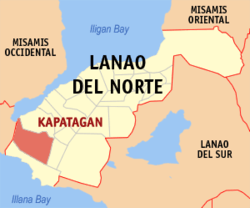Kapatagan, Lanao del Norte
| Kapatagan | |
|---|---|
| Municipality | |
| Municipality of Kapatagan | |
 Map of Lanao del Norte with Kapatagan highlighted | |
.svg.png) Kapatagan Location within the Philippines | |
| Coordinates: 7°54′N 123°46′E / 7.9°N 123.77°ECoordinates: 7°54′N 123°46′E / 7.9°N 123.77°E | |
| Country |
|
| Region | Northern Mindanao (Region X) |
| Province | Lanao del Norte |
| District | 2nd District |
| Founded | July 5, 1949 |
| Barangays | 33 (see Barangays) |
| Government [1] | |
| • Type | Sangguniang Bayan |
| • Mayor | Benjie Y. Baguio |
| • Vice Mayor | Perlito B. Gonzaga |
| • Electorate | 28,967 voters (2016) |
| Area [2] | |
| • Total | 242.89 km2 (93.78 sq mi) |
| Population (2015 census)[3] | |
| • Total | 62,853 |
| • Density | 260/km2 (670/sq mi) |
| Time zone | UTC+8 (PST) |
| ZIP code | 9214 |
| PSGC | 103505000 |
| IDD : area code | +63 (0)63 |
| Climate type | Tropical climate |
| Income class | 2nd municipal income class |
| Revenue (₱) | 158,650,256.80 (2016) |
| Native languages |
Maranao Cebuano Binukid Tagalog |
| Website |
www |
Kapatagan, officially the Municipality of Kapatagan, is a 2nd class municipality in the province of Lanao del Norte, Philippines. According to the 2015 census, it has a population of 62,853 people.[3]
Geography
Kapatagan has a total land area of 25,048.41 hectares which include the area that is now being contested by the Municipality of Lala with an approximate area of 759 hectares.
Topography
On the southern and eastern sides of the locality are mountains which serve as natural barriers protecting the Municipality from typhoons. Offsetting the mountain is the presence of flat coastal lands and valley. Kapatagan has some rolling plains.
It has five (5) major rivers that flow to Panguil Bay, namely: Maranding, Panoloon, Butadon, Kidalos, and Balili. These rivers sometimes, especially during the rainy season, overflow causing floods resulting to destruction and even death of farm and land animals.
The Cathedral Falls and Sta. Cruz waterfalls are located at Barangays Cathedral Falls, Sta. Cruz, and Waterfalls respectively. At present, the spring supplies water into Poblacion and some neighboring barangays.
Climate
The Municipality has a tropical climate. Dry season starts during the month of October and ends in June. Wet season starts in the month of July and ends in December.
Barangays
Kapatagan is politically subdivided into 33 barangays.
- Bagong Badian
- Bagong Silang
- Balili
- Bansarvil
- Belis
- Buenavista
- Butadon
- Cathedral Falls
- Concepcion
- Curvada
- De Asis
- Donggoan
- Durano
- Kahayagan
- Kidalos
- La Libertad
- Lapinig
- Mahayahay
- Malinas
- Maranding
- Margos
- Poblacion
- Pulang Yuta
- San Isidro
- San Vicente
- Santa Cruz
- Santo Tomas
- Suso
- Taguitic
- Tiacongan
- Tipolo
- Tulatulahan
- Waterfalls
Demographics
| Population census of Kapatagan | ||
|---|---|---|
| Year | Pop. | ±% p.a. |
| 1918 | 1,825 | — |
| 1939 | 2,677 | +1.84% |
| 1948 | 14,103 | +20.28% |
| 1960 | 32,060 | +7.08% |
| 1970 | 20,140 | −4.54% |
| 1975 | 21,055 | +0.90% |
| 1980 | 25,303 | +3.74% |
| 1990 | 33,397 | +2.81% |
| 1995 | 37,006 | +1.94% |
| 2000 | 42,783 | +3.16% |
| 2007 | 49,134 | +1.93% |
| 2010 | 53,916 | +3.44% |
| 2015 | 62,853 | +2.96% |
| Source: Philippine Statistics Authority[3][4][5][6] | ||
Economy
The municipality is beginning to gain economic favor mainly due to the funds released by some international organizations like GEM. Many companies will plan to build some stores in Kapatagan to boost its economic growth like Mercury Drugstore, Mluiller Pawnhsop, Cebuana Pawnshop, Palawan Pawnshop, Julies Bakeshop and Vina Shopping Center.
References
- ↑ "Municipality". Quezon City, Philippines: Department of the Interior and Local Government. Retrieved 31 May 2013.
- ↑ "Province: Lanao del Norte". PSGC Interactive. Quezon City, Philippines: Philippine Statistics Authority. Retrieved 12 November 2016.
- 1 2 3 Census of Population (2015). "Region X (Northern Mindanao)". Total Population by Province, City, Municipality and Barangay. PSA. Retrieved 20 June 2016.
- ↑ Census of Population and Housing (2010). "Region X (Northern Mindanao)". Total Population by Province, City, Municipality and Barangay. NSO. Retrieved 29 June 2016.
- ↑ Censuses of Population (1903–2007). "Region X (Northern Mindanao)". Table 1. Population Enumerated in Various Censuses by Province/Highly Urbanized City: 1903 to 2007. NSO.
- ↑ "Province of Lanao del Norte". Municipality Population Data. Local Water Utilities Administration Research Division. Retrieved 17 December 2016.